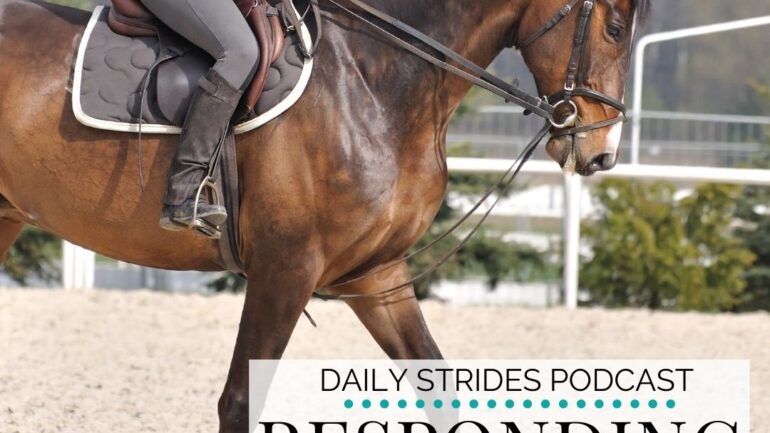How do some riders seem to simply handle ‘speed wobbles’ when they are riding? It seems as though nothing phases them. They simply effectively and efficiently get things back on track with minimum effort and drama… Their secret? They have swapped reacting versus responding when they ride.
If you are the sort of rider who gets ‘triggered’ by certain things in your riding, you have possibly looked at those ‘other’ riders with a mixture of awe and jealously!
Today I want to tell you exactly how you can begin riding like them; and begin responding rather than reacting when riding, and working with, your horse.
What’s a Reaction?
Reacting is impulsive, instant, and, usually, does not help the situation you find yourself in. It is when you have a ‘worn path’ in your mind. “If this happens, do that.” Literally.
A reaction is usually created by ‘that’ has helped you at some point in your life when you felt a certain feeling.
The trouble is, now every time you feel that same feeling, your body automatically jumps to ‘this’ reaction, even when ‘this’ reaction is not helping you at all in your current situation. For example, you feel like you are being ignored and you begin shouting and using more aggressive body language. Or you feel like you are in danger, so you cower away and try to look for ways to hide.
Those reactions may have helped you at a different point in your life. But I can almost guarantee that they are not serving you right now in your riding.
What’s a Response?
A response is a calculated action or series of actions that you take in order to get the desired outcome. Often, the correct response when riding can feel like it is in complete opposition to how you would normally react.
The key to responding well is to remain committed to your intention. This is as you take action that will move the conversation with your horse closer to it.
As an equestrian, it is important that you continually look for areas in your riding where you are reacting rather than responding. A specific transition. Or perhaps when your horse does something. A good way to assess if you need to begin working on a response, rather than the current reaction, can be looking for areas where progress is ‘stuck’.
Reacting Versus Responding
The trouble with reacting is that it keeps you ‘stuck’ and focused on the very thing that has triggered you. The focus for the ride moves away from your initial intention. And towards the very thing that you, clearly, don’t enjoy so much!
Responding allows you to mindfully and intentionally re-direct the focus back to your initial goal, movement or task at hand.
Now, I want to encourage you here a little. ALL riders have certain things that they react to. Yes, all riders. This is due to the fact that we can place so many of the basics onto autopilot in our riding. Autopilot is not a bad thing. In fact, it is the very thing that will help you to begin working on more complex ‘conversation topics’ with your horse.
The key is to ‘revisit’ those autopilot basics regularly and upgrade as you do to align with your current riding skills and mindset.
Moving Towards Responsive Riding
If you have identified something that you feel you are, indeed, guilty of reacting to on a regular basis, congratulations! Actually seeing that this is the case is the first step towards moving from reacting versus responding in your riding. However, you will also know realise that you are only noticing long after the reaction has happened!
My first suggestion is that as soon as you catch yourself reacting, begin thinking about how you potentially could have responded differently.
Keep the focus on your desired outcome and figure out what would have potentially gotten you to that point easier and with less stress if that same trigger occured again.
After doing this a few times, you will begin ‘resetting’ your reaction clock closer and closer to the trigger itself. Soon you will actually notice yourself reacting while still ‘in the thick of it’! When that happens (yes, it will), simply make those better decisions and take those more responsive actions.
Responsiveness is a Habit
Overtime, you will find yourself reacting less and less to each potential trigger. You will allow yourself hte space to take a more measured, mindful response. That response has the potential to really begin re-shaping your overall conversation with your horse.
Responsivenss is a muscle. The more you use it the right way, the stronger it will become.
And the stronger it becomes, the easier it will be for you to use this in your riding to help steer the course of each conversation between you and your horse.
Happy Riding
Lorna
Additional Resources for Equestrians
-
-
- Connection; My Online Membership for Equestrians
- FREE Half Halt Training Audio
- The Direct Relationship Between Your Fitness & Your Riding
- Dealing with a Horse who Spooks and Spins
- Diffusing a Difficult or Dangerous Situation
- Online community for equestrians working on their mindset & fitness
- Online Community for equestrians focusing on re-schooling horses (and ex-racehorses)
-

